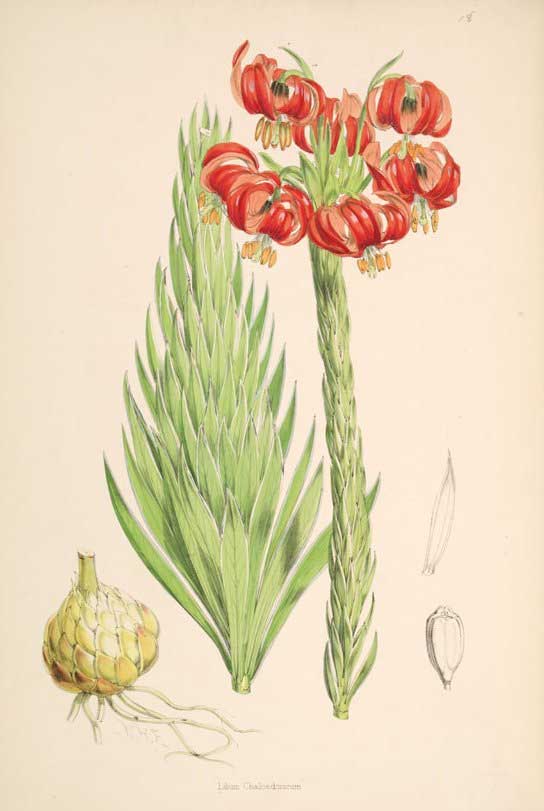
Lilium chalcedonicum (*)
Classification System: APG IV
Superregnum: Eukaryota
Regnum: Plantae
Cladus: Angiosperms
Cladus: Monocots
Ordo: Liliales
Familia: Liliaceae
Subfamilia: Lilioideae
Genus: Lilium
Sectio: L. sect. Pseudolirium
Species: Lilium columbianum
Name
Lilium columbianum Leichtlin, 1871
Synonyms
Heterotypic
Lilium canadense var. parviflorum Hook., Fl. Bor.-Amer. 2: 181 (1838), descriptive, not intended as an epithet.
Lilium canadense var. minus Alph.Wood, Proc. Acad. Nat. Sci. Philadelphia 20: 166 (1868).
Lilium canadense var. walkeri Alph.Wood, Proc. Acad. Nat. Sci. Philadelphia 20: 166 (1868).
Lilium californicum Duch., J. Soc. Natl. Hort. France, sér. 2, 4: 216 (1870).
Lilium sayi Nutt. ex Duch., J. Soc. Natl. Hort. Paris, sér. 2, 5: 273 (1871).
Lilium canadense var. californicum (Duch.) Bol., Garden (London, 1871-1927) 5: 1 (1874), nom. superfl.
Lilium parviflorum (Hook.) W.G.Sm., Fl. Mag. (London), n.s., 1874: t. 136 (1874).
Lilium lucidum Kellogg, Proc. Calif. Acad. Sci. 6: 144 (1875 publ. 1876).
Lilium nitidum W.Bull ex Baker, Gard. Chron., n.s., 14: 198 (1880).
Lilium bakeri Purdy, Erythea 5: 104 (1897).
Lilium purdyi Waugh, Bot. Gaz. 27: 356 (1899).
Distribution
Native distribution areas:
Continental: Northern America
Regional: Canada
British Columbia
Regional: Western USA
California, Idaho, Montana, Oregon, Washington
References: Brummitt, R.K. 2001. TDWG – World Geographical Scheme for Recording Plant Distributions, 2nd Edition
References
Primary references
Leichtlin, M., 1871. J. Soc. Centr. Hort. France 5:98.
Additional references
Flora of North America Editorial Committee (ed.) 2002. Flora of North America North of Mexico. Volume 26: Magnoliophyta: Liliidae: Liliales and Orchidales. 723 pp. Oxford University Press, New York / Oxford, ISBN 0-19-515208-5. efloras Reference page.
Links
Govaerts, R. et al. 2022. Lilium columbianum in World Checklist of Selected Plant Families. The Board of Trustees of the Royal Botanic Gardens, Kew. Published online. Accessed: 2022 July 30. Reference page.
Hassler, M. 2022. Lilium columbianum. World Plants: Synonymic Checklists of the Vascular Plants of the World In: Roskovh, Y., Abucay, L., Orrell, T., Nicolson, D., Bailly, N., Kirk, P., Bourgoin, T., DeWalt, R.E., Decock, W., De Wever, A., Nieukerken, E. van, Zarucchi, J. & Penev, L., eds. 2022. Species 2000 & ITIS Catalogue of Life. Published online. Accessed: 2022 July 30. Reference page.
Tropicos.org 2022. Lilium columbianum. Missouri Botanical Garden. Published online. Accessed: 30 July 2022.
International Plant Names Index. 2022. Lilium columbianum. Published online. Accessed: July 30 2022.
Vernacular names
English: Columbia Lily
français: Lys de Colombie
Lilium columbianum is a lily native to western North America.[2][3] It is also known as the Columbia lily, Columbia tiger lily, or simply tiger lily (sharing the latter common name with several other lily species in its genus).
Distribution and habitat
Lilium columbianum occurs in lowland and montane forest openings and meadows from southern British Columbia in Canada south to northern California and east to Montana in the northwestern United States.[2][4] Mostly occurring below 2,000 m (6,600 ft), it usually blooms in June through early August.[2] There are a few isolated populations at high elevations in the Sierra Nevada as far south as Fresno County.[5][6]
Description
Lilium columbianum is a perennial herb[7] that grows up to 1.2 metres (3.9 ft) tall, and bears from few to numerous orange flowers with darker spots. The tepals are 3 to 6 cm long and the flowers are lightly scented. Like many true lilies, the leaves are arranged in whorls around the stem of the plant.[8][9][10][5][11]
Uses
Food
Coast Salish, Nuu-chah-nulth and most western Washington peoples steamed, boiled or pit-cooked its bulbs. Bitter or peppery-tasting, they were mostly used as a flavoring, often in soup with meat or fish.[12]
Horticulture
From seed, Lilium columbianum requires three to five years to mature. Cultivated bulbs can be divided or bulb scales may be used to generate new plants more quickly.[13]
References
Kew World Checklist of Selected Plant Families
Sullivan, Steven. K. (2015). "Lilium columbianum". Wildflower Search. Retrieved 2016-04-09.
"Lilium columbianum". PLANTS Database. United States Department of Agriculture; Natural Resources Conservation Service. 2015. Retrieved 2016-04-09.
Biota of North America Program 2014 county distribution map
"Lilium columbianum". Jepson eFlora: Taxon page. Jepson Herbarium; University of California, Berkeley. 2015. Retrieved 2016-04-09.
Calflora taxon report, Lilium columbianum Baker Columbia lily, Columbian lily, Oregon lily
"Lady Bird Johnson Wildflower Center - The University of Texas at Austin". www.wildflower.org. Retrieved 2022-06-11.
"Lilium columbianum in Flora of North America @ efloras.org". www.efloras.org.
Klinkenberg, Brian, ed. (2014). "Lilium columbianum". E-Flora BC: Electronic Atlas of the Plants of British Columbia [eflora.bc.ca]. Lab for Advanced Spatial Analysis, Department of Geography, University of British Columbia, Vancouver. Retrieved 2016-04-09.
Giblin, David, ed. (2015). "Lilium columbianum". WTU Herbarium Image Collection. Burke Museum, University of Washington. Retrieved 2016-04-09.
Hitchcock, C. Leo; Cronquist, Arthur (1973). Flora of the Pacific Northwest; an illustrated manual. Seattle: University of Washington Press. ISBN 0295952733.
Pojar, Jim (2004). Plants of the Pacific Northwest Coast. Edmonton: Lone Pine Publishing. ISBN 9781551055305.
Kruckeberg, Arthur R. (1996). Gardening with Native Plants of the Pacific Northwest: Second Edition. Seattle: University of Washington Press. ISBN 9780295974767.
Retrieved from "http://en.wikipedia.org/"
All text is available under the terms of the GNU Free Documentation License

